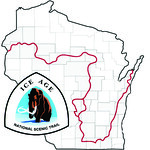A cuesta is a ridge which has a steep escarpment on one side and a long gentle slope on the other.
Martin, Lawrence. THE PHYSICAL GEOGRAPHY OF WISCONSIN © 1965 by the Board of Regents of the University of Wisconsin System. Reprinted by permission of The University of Wisconsin Press.
 The well-known Niagara Escarpment to the east was created in the Silurian Age, approximately 433.7 million years ago when the first true coral reefs were formed. The top varies from 740 to 1,200 feet above sea level.
The well-known Niagara Escarpment to the east was created in the Silurian Age, approximately 433.7 million years ago when the first true coral reefs were formed. The top varies from 740 to 1,200 feet above sea level.
The Magnesian Cuesta is 54.6 million years older than the Niagara Escarpment. It was formed during the Ordovician Age, approximately 488.3 million years ago when Brachiopod fossils were common. The top varies from 700 to 1,100 feet above sea level; generally slightly lower than the Niagara Escarpment.
Both the Niagara and Magnesian Cuesta were formed by deposits of dolomite in shallow seas. Both have a steep, west facing escarpment and a long, gentle slope, (approximately 5 feet per mile) to the east. Some of the elevation on these cuestas may be due to a thin covering of glacial drift.
The Magnesian Cuesta is approximately 175 miles long in Wisconsin. There is a general increase in height of approximately 500 feet from Marinette County in the northeast to Dane County in the southwest. The width also increases from the northeast, where it is 2-7 miles wide, to the southwest, where it is 10-20 miles wide.
The Magnesian Cuest is simple in outline with just a few salients. A salient is a section that has been isolated by erosion (in pre-glacial time), and becomes a flat topped butte or mesa. Gibraltor Rock, at 1240 feet high, is the highest outlier of the Magnesian Cuesta; (see GC1Z45H - This Gibraltar Rock is Really Lying Out There).
 IATCC is the cache designation to highlight a series of EarthCaches along the Ice Age National Scenic Trail grouped into a special category called "ColdCache."
IATCC is the cache designation to highlight a series of EarthCaches along the Ice Age National Scenic Trail grouped into a special category called "ColdCache."
The Ice Age Trail is one of eleven National Scenic Trails designated by the National Park Service. This unique trail is entirely within the state of Wisconsin and follows along the terminal moraine of the most recent glacier which retreated about 10,000 years ago.
This project is supported by the Ice Age Trail Alliance (IATA). The goal is to bring more visitors to the trail and promote public awareness, appreciation, and understanding of Wisconsin’s glacial landscape.
The IATA has created an awards program to encourage visits to the trail and ColdCache sites. This awards program is separate from, and in addition to, any other Geo- or EarthCache awards program.
A current list of approved ColdCache sites can be found on the “IATCC Bookmark List”. More information on the Ice Age Trail Atlas, the Companion Guide, the ColdCache Project and Awards Program can be found on the “ColdCache Webpage”
DNR Permission
The Geocache Notification Form has been submitted to Andy Paulios of the Wisconsin DNR. Geocaches placed on Wisconsin Department of Natural Resource managed lands require permission by means of a notification form. Please print out a paper copy of the notification form, fill in all required information, then submit it to the land manager. The DNR Notification form and land manager information can be obtained at: www.wi-geocaching.com/hiding
Resources
Geology of the Ice Age National Scenic Trail; by David M. Mickelson, Louis J. Mahler Jr., and Susan L. Simpson
Ice Age Trail Guidebook 2014; A Publication of the Ice Age Trail Alliance
The Physical Geography of Wisconsin; by Lawrence Martin
To claim this find:
Check the elevations for the top of each outcrop and the overlook. Make note of the surrounding area at each location. Explain the differences you observe.